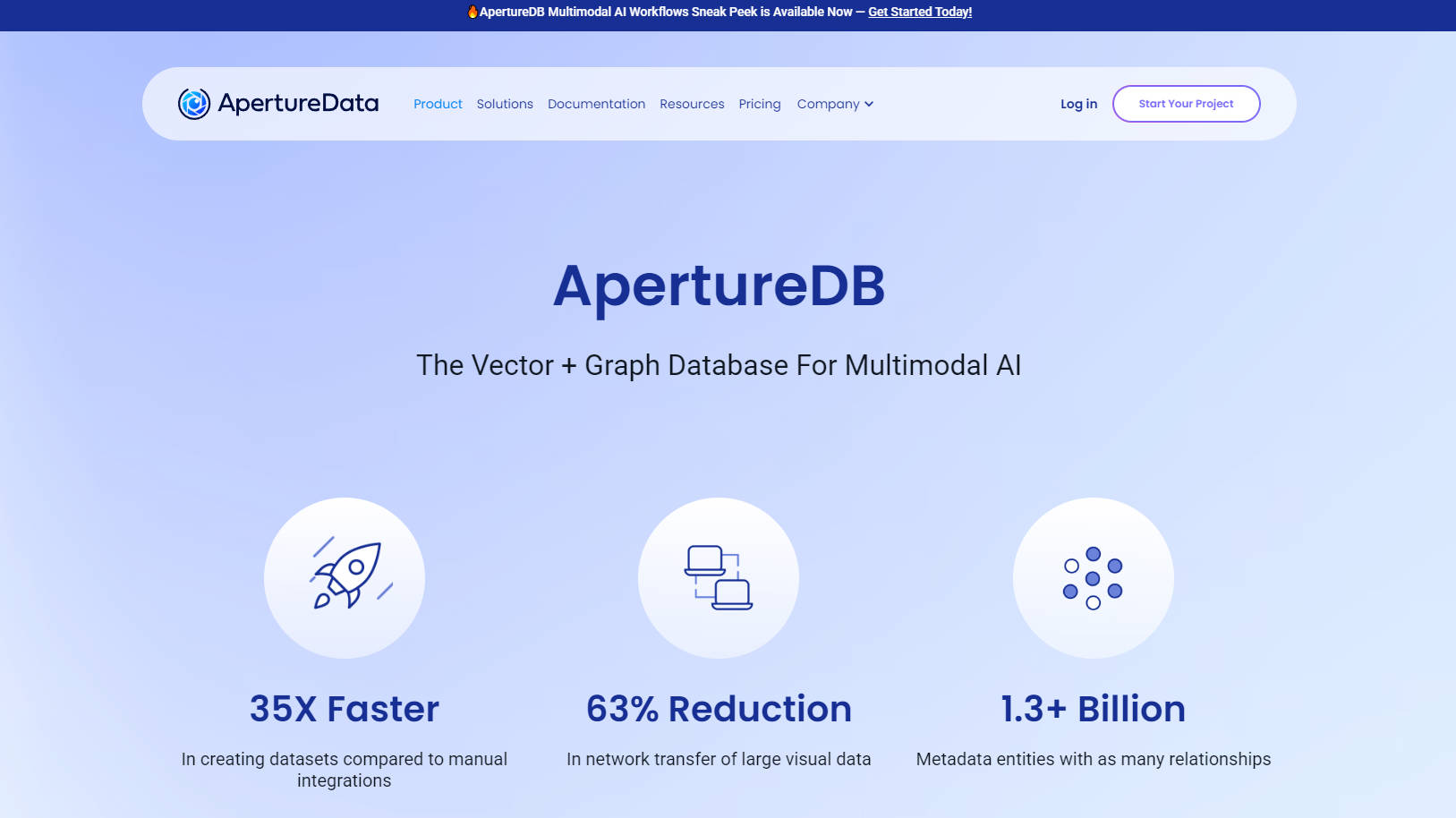
What is ApertureData?
Building AI applications that leverage the power of multimodal data (images, videos, text, and more) can be incredibly complex. You're often juggling multiple databases, struggling with data silos, and spending valuable time on infrastructure instead of innovation. ApertureDB solves this problem. It's a unified database solution designed specifically for multimodal AI, combining the power of vector search, knowledge graphs, and efficient data management into a single, streamlined platform.
Key Features:
🔨 Unify Multimodal Data: Manage images, videos, text, documents, and associated metadata natively within a single database. No more jumping between different systems.
🚀 Accelerate Vector Search: Perform high-speed similarity searches across massive collections of high-dimensional embeddings (feature vectors). ApertureDB offers 2-4x faster vector search compared to typical setups.
🔗 Build Powerful Knowledge Graphs: Represent complex relationships between your data points using a robust, integrated knowledge graph. Easily add and update metadata without messy schema changes.
⚙️ Streamline Data Augmentation: Prepare your datasets for machine learning on-the-fly. ApertureDB handles image and video preprocessing (zoom, crop, sampling) directly, reducing data bloat.
☁️ Deploy Anywhere: ApertureDB is cloud-agnostic, offering flexible deployment options: cloud, virtual private cloud (VPC), Google Cloud Platform (GCP), AWS, Docker Containers, or on-premises.
🤝 Integrate Seamlessly: ApertureDB plays well with your existing AI tech stack, including AI/ML frameworks, open-source libraries, language models, and storage solutions.
Use Cases:
Enhanced Product Search for E-commerce: Imagine a customer searching for a "red floral dress." Instead of just relying on text keywords, ApertureDB enables your e-commerce platform to use visual similarity search. The customer could upload a picture of a dress they like, and ApertureDB would instantly find visually similar items in your catalog, even if the product descriptions don't perfectly match the customer's wording. This leads to more relevant results and a better shopping experience.
Generative AI Content Moderation: A social media platform uses ApertureDB to power its content moderation system. ApertureDB stores embeddings of known inappropriate content (images and videos). When new content is uploaded, ApertureDB quickly compares it to the existing embeddings, flagging potentially harmful content for review. The knowledge graph component allows the system to understand the context surrounding the content, reducing false positives and improving accuracy.
AI-Powered Medical Diagnosis Assistance: A hospital uses ApertureDB to store and analyze medical images (X-rays, MRIs). Doctors can use the system to find visually similar cases, compare scans, and access relevant annotations and metadata. This helps them make more informed diagnoses and treatment decisions. The integrated knowledge graph connects patient data, medical history, and imaging results, providing a holistic view.
Conclusion:
ApertureDB empowers you to build and deploy multimodal AI applications faster and more efficiently. By removing the complexities of data management, ApertureDB frees your team to focus on what matters most: creating innovative AI solutions. It reduces infrastructure setup time by 6-9 months and offers a low and predictable total cost of ownership.
FAQ:
Q: What types of data can ApertureDB handle?
A: ApertureDB is designed for multimodal data, including images, videos, text, documents, feature vectors (embeddings), and associated metadata (like annotations and bounding boxes).
Q: How does ApertureDB improve vector search performance?
A: ApertureDB utilizes optimized indexing and search algorithms, building on top of the FAISS library, to achieve 2-4x faster vector search compared to traditional setups. It also allows for customizable engines and distance metrics.
Q: How does ApertureDB integrate with my existing AI workflow?
A: ApertureDB offers a unified JSON-based query language and integrates seamlessly with popular AI/ML frameworks, open-source libraries, and language models. It supports batch data access for large-scale training and inference.
Q: What are the security features of ApertureDB? A: ApertureDB provides enterprise-grade security, including role-based access control, user management, authentication, and SSL-encrypted communication.
Q: What is the core architecture of ApertureDB? A: The core architecture consists of a Vector Database (using FAISS for similarity search), a Graph Database (for metadata and relationships), a Multimodal Data Management layer (handling preprocessing with OpenCV and ffmpeg), and a Unified Query Interface (using a JSON-based query language).
Q: How is ApertureDB different from other databases? A: ApertureDB is unique because of the following: it supports multimodal ACID transactions, it is cloud-agnostic, it performs data augmentation on the fly, it supports multimodal queries with a combination of vector and metadata constraints, it allows for annotations of regions of interest in images, and it integrates into AI/ML workflows.






